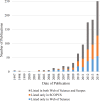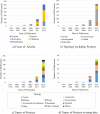An Analysis of Citizen Science Based Research: Usage and Publication Patterns
- PMID: 26600041
- PMCID: PMC4658079
- DOI: 10.1371/journal.pone.0143687
An Analysis of Citizen Science Based Research: Usage and Publication Patterns
Abstract
The use of citizen science for scientific discovery relies on the acceptance of this method by the scientific community. Using the Web of Science and Scopus as the source of peer reviewed articles, an analysis of all published articles on "citizen science" confirmed its growth, and found that significant research on methodology and validation techniques preceded the rapid rise of the publications on research outcomes based on citizen science methods. Of considerable interest is the growing number of studies relying on the re-use of collected datasets from past citizen science research projects, which used data from either individual or multiple citizen science projects for new discoveries, such as for climate change research. The extent to which citizen science has been used in scientific discovery demonstrates its importance as a research approach. This broad analysis of peer reviewed papers on citizen science, that included not only citizen science projects, but the theory and methods developed to underpin the research, highlights the breadth and depth of the citizen science approach and encourages cross-fertilization between the different disciplines.
Conflict of interest statement
Figures
References
-
- Miller-Rushing A, Primack R, Bonney R. The history of public participation in ecological research. Frontiers in Ecology and the Environment. 2012;10(6):285–90. 10.1890/110278 - DOI
-
- Tian HD, Stige LC, Cazelles B, Kausrud KL, Svarverud R, Stenseth NC, et al. Reconstruction of a 1,910-y-long locust series reveals consistent associations with climate fluctuations in China. Proceedings of the National Academy of Sciences of the United States of America. 2011;108(35):14521–6. 10.1073/pnas.1100189108 - DOI - PMC - PubMed
-
- Irwin A, Georg S, Vergragt P. THE SOCIAL-MANAGEMENT OF ENVIRONMENTAL-CHANGE. Futures. 1994;26(3):323–34. 10.1016/0016-3287(94)90018-3 - DOI
-
- Bonney R, Cooper CB, Dickinson J, Kelling S, Phillips TB, Rosenberg KV, et al. Citizen Science: A Developing Tool for Expanding Science Knowledge and Scientific Literacy. Bioscience. 2009;59(11):977–84. 10.1525/bio.2009.59.11.9 - DOI
-
- European Commission. Green Paper on Citizen Science. 2013.
MeSH terms
LinkOut - more resources
Full Text Sources
Other Literature Sources
Miscellaneous





